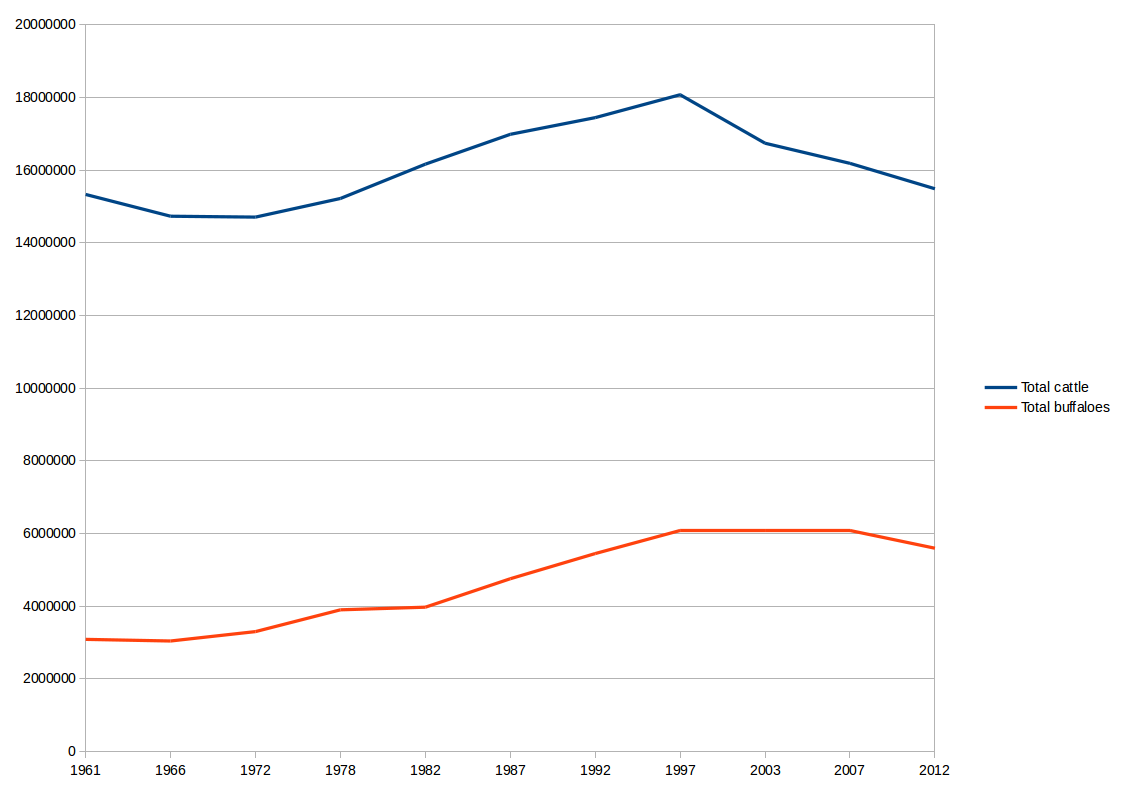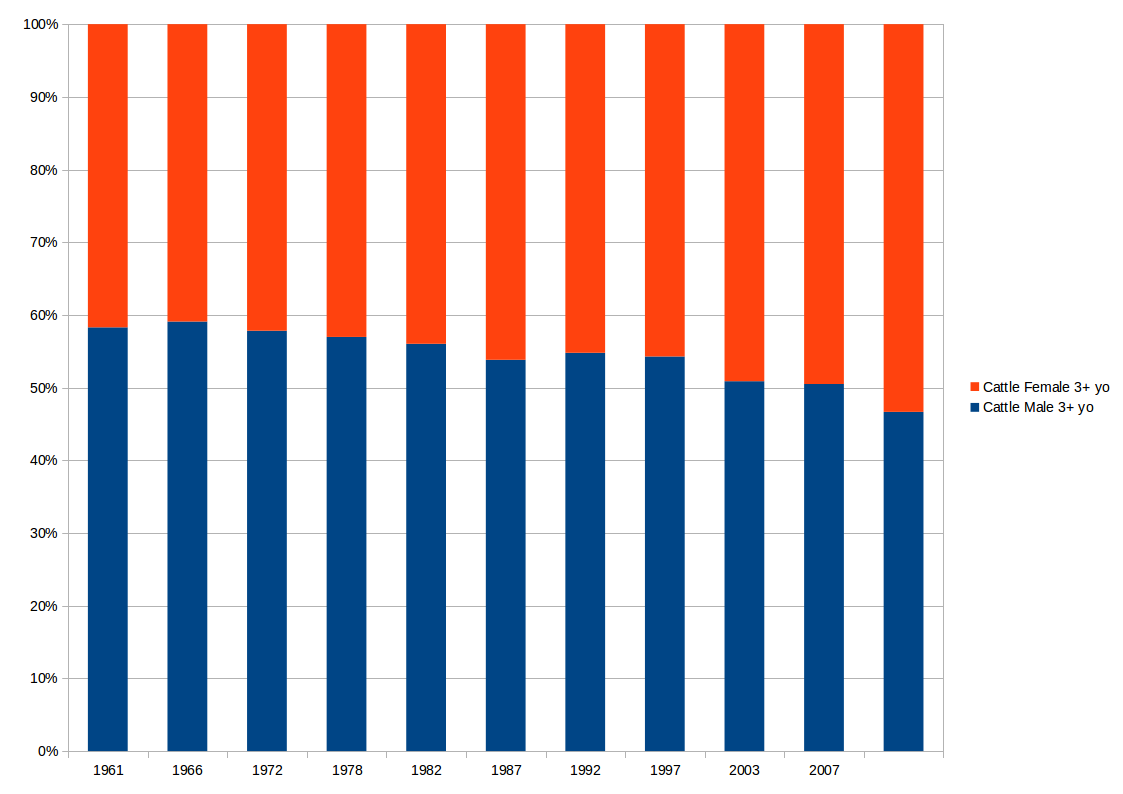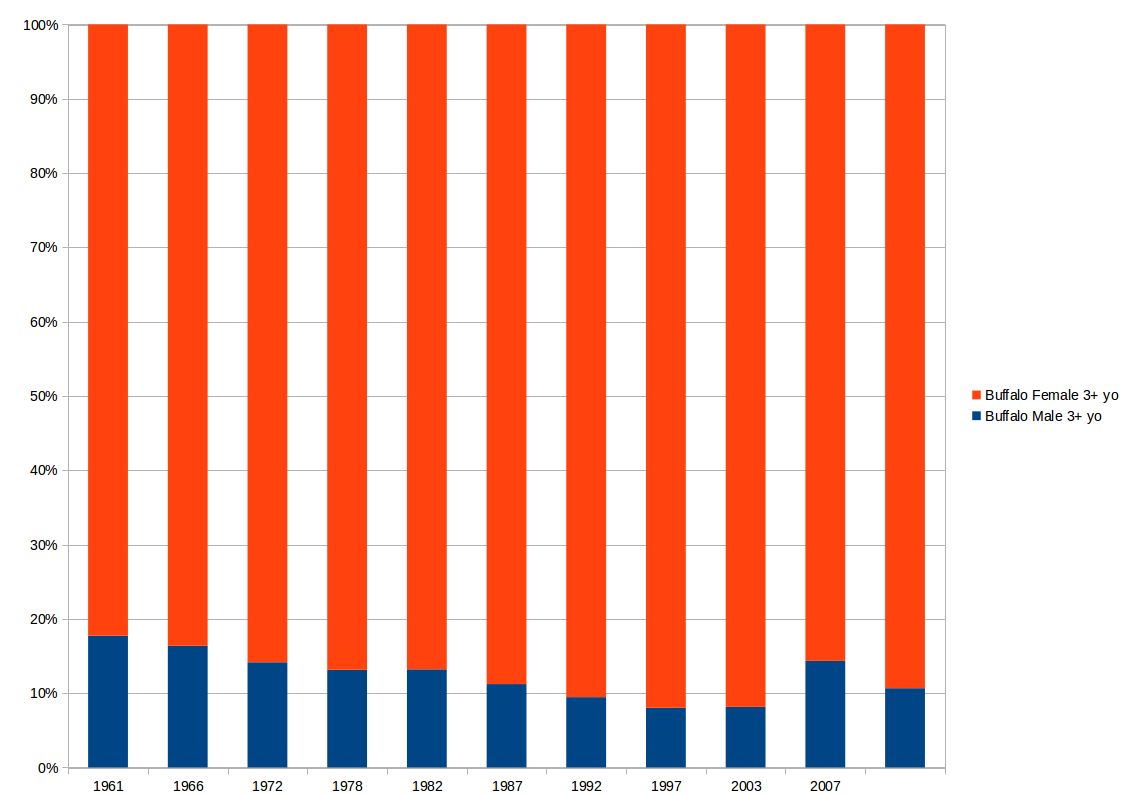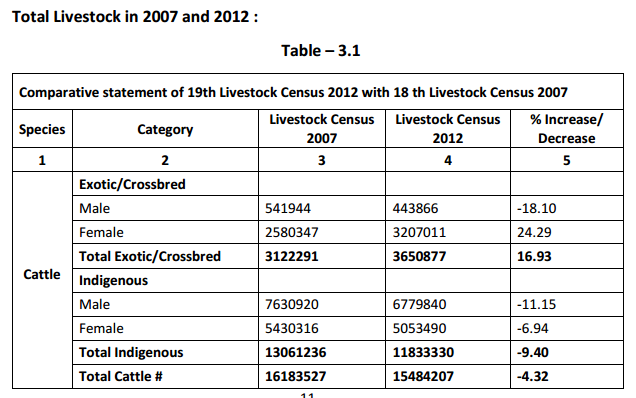In an attempt to bring reason to the debate on cow slaughter bans, I have tried to present data from Maharashtra where the broadening of an existing ban on the slaughter of cows to include calves, bulls and bullocks has the poor cattle owners of the drought stricken state devastated as their livestock has overnight become a liability.
The sentiment about the holy cow is beyond doubt. Upper caste Hindus revere the cow, even though there are many Hindus who do eat it. Whether Savarkar agreed with it or whether the vedas sanctioned it is irrelevant. The idea of cow slaughter is revolting to many Hindus.
However, as sentimentalism and hyperbole builds up, there is a need to take a long, hard look at realities, and for the government that claims to be interested in development to decide whether development lies in the past or in building a new future.
Here is the data from the various livestock census reports from Maharashtra and what it tells me.
Firstly, the numbers.

A quick glance at the numbers is enough to tell us that in the five decades since the first census data available in 1961 and till the 2012 19th livestock census, the population of cattle has grown by 1,56,632 or slihtly more than a lakh and a half. The population of buffaloes has grown by 25,07,378 or over 25 lakh – about five lakhs short of being doubled. While this, in itself is an astonishing difference, it becomes even more astonishing when we see that the population of cattle was almost five (4.9) times that of buffaloes in 1961 and in 2012, cattle are slightly more than two and a half (2.7) times that of buffaloes. So this dramatic increase has happened in a much smaller population.

AND, the buffaloes were also getting slaughtered all through, for food.
If you look at the break ups of the population, you will see this more clearly.

The line lying almost flat against the bottom is the population of male buffaloes, which has barely ever risen other than around 2007 and 2012 – recent years saw distinct radicalization of society against slaughter. This fluctuation, 2007 in particular, could also be explained if the census happened before the festival season when a lot of the slaughter happens. And in five decades, out of the 25 lakh rise in buffaloes, not even a tenth or two and a half lakhs has happened in the male population. And of course India is the world’s largest exporter of carabeef (buffalo beef).
Not only do buffalo owners profit from the high yields of the buffalo, and then an income from the sale of the unproductive animals for slaughter, they also do not feed much surplus livestock unnecessarily.
If you take the total population of buffaloes to be 100%, the sex ratio for cows and buffaloes would be thus over the years.

The only time in the history of the livestock census in Maharashtra that cows have been more than bulls and bullocks is in the year 2012, though the trend starts at 1997 (also relevant later). If you look at the data, you will see that the numbers dropped more drastically than for cows. This basically means that for the first time in Maharashtra, bulls and bullocks were being butchered in any noticeable numbers. But why now, if not for five decades? We will look at the 2012 data in detail in a bit.

The ratio of male buffaloes to female buffaloes consistently hovers between 8% and 18% – we aren’t even pretending gender equality here. 50% is far away in the stratosphere, let alone male buffaloes being the majority of the population. At no point does the male buffalo population even touch 20%.
But the buffalo population did slow in 2007 and fall in 2012 in particular. So did the overall population of cows, which has been falling steadily since the late 90s.
Explanations for changes in trends in livestock data can be found in events that impacted livestock farming practices.
Cow population started dropping after 1997
What else was happening in the agricultural world around that time? Maharashtra’s post-economic liberalization agrarian crisis had established. By 1995, P. Sainath’s reports of farmer suicides in rural India had triggered enough alarm that they had started being recorded in NCRB data. While livestock, as an economic asset provides a buffer against poverty, to me it seems like it lost its potency by 1997 with the agrarian crisis creating a similar situation for most cattle owners.
At this point, the farmers were committing suicide, but still there is no noticeable slaughter of bulls and bullocks. However, the overall populations started dropping steadily as cows started becoming economically unviable.
Understand this, when less than 50% of the cattle population is cows, milk producing cows are even fewer, so cattle owners probably had two unproductive animals for every milch cow. With the rise of motorized transport, while bullock carts could be used for own needs and ploughing the fields could be done, income earning opportunities from bulls and bullocks started dwindling (and are near non-existent today).
What happened in 2012?
The worst drought to hit Maharashtra happened in 2012. People were desperate for water for themselves. Buffaloes actually have higher water requirements than cows (“water buffalo” d’uh). Buffalo owners seem to have sold off their livestock in greater than usual numbers. This is probably also a factor in India becoming the world’s largest exporter of beef at that time.
What was happening with the cows in 2012?
The cattle population continued to drop, except for two major departures from the norm till then.
The population of exotic and crossbred cows rose
While all the other cattle and buffalo population was busy going down, the one notable exception was the population of exotic and crossbred cows – this would be your fancy imported dairy breeds with very high production. Their requirements of water would be less than buffaloes, and milk production would be comparable. Indigenous cows, on the other hand, barely produce enough to justify a business if it also means caring for an unproductive cow later. Those continued to reduce.

Actually, the crossbred and exotic cattle population has been showing a steady rise all through, it only became visible here, when everything else went down. The rise in the number of exotic and crossbred cows (usually reared for dairy business because of high yields and correspondingly high dietary requirements), combined with the highest drop in male cattle also belonging to the same category shows that the more progressive dairy businesses were moving toward a pragmatism in their business model.
Dramatic drop in male cattle numbers
Male exotic and cross bred cattle saw the highest drops (they are less suitable/sturdy for local climates and work AND they require more feed and water). Male indigenous cattle too saw a drop. For the first time in the history of the livestock census in India, Maharashtra has more cows than male cattle. To put it bluntly, when food and water got scarce, male cattle were the ones sacrificed in greater numbers – either to butchers or starvation and dehydration in abandonment.
My views on what the government should have done, as opposed to what it did
In the absence of slaughter bans, cattle farming is actually more profitable than buffaloes
This is because buffaloes require more care, water and suffer more in drought – which seems to be a permanent feature of Maharashtra now. In the absence of slaughter bans, cow beef is more palatable and thus priced higher than carabeef, which would add to the income of the cattle farmers and make it a viable choice.
Given the lack of any real increase in the cattle population in Maharashtra (similar is seen nationwide), the government should have taken the initiative to free people from traditional taboos against cattle slaughter and encouraged them to sell cattle to middlemen, even as they themselves remained reluctant to engage in slaughter or consumption.
This would not only make cattle farming viable and result in similar increases in population and quality of cattle as with buffaloes, and reduce non-productive investments for the already stressed agrarian economy, it would allow better treatment of cattle, instead of abandonment, injury and worse. It is a matter of debate which is the greater cruelty – a quick death or a week in pain with a stomach full of plastc or legs broken by an irate farmer whose crops stray cattle destroyed. Having fewer non-productive cattle would mean a better diet and care to cows and calves. It would mean optimal use of scarce grazing, fodder and water, which would indeed go to the revered milk producing cow.
It was a matter of educating the people and leading them to economic viability – is that not the government’s pet grudge? That the poor are given handouts when what they need is sustainability?
Instead, the government chose to take Maharashtra back to a rigid cow worship as a part of their ideological agenda, but funded by the already stressed cattle owners, turning their investments to liabilities overnight for the sentiments of those who don’t raise (and thus serve) the cows themselves at all. It chose to smother the budding realization of the need to reduce male cattle – even if triggered by desperate circumstances and protect the cattle instead of the people. It put the welfare of an animal over that of its voters. That is the bottom line. An open declaration that the state that leads the nation in farmer suicide still expects farmers to spend on unproductive cattle, even as government actions have brought an unending drought.
Basically, the government has turned the cow into its murder weapon. And no, I am not talking of its murderous affiliates slaughtering humans by leveraging rumors here. Is it not murder for a state that sees educated girls give up on non-existent jobs and dreams of marriages and turn to prostitution to feed starving families to force them to fund the government’s cattle fetish as well? Is it not murder to force an expense on farmers, remove an alternative to loans and debt in the state that leads the country in farmer suicides? Because that is how it is, you know? Sell a bull instead of taking a loan. Buy another after harvest. Instead, the bull is now unsaleable, and the loan the farmer takes must feed it as well.
What lies in the future?
In my view, unless the oh-so-posh idealistic middle classes are willing to live without milk, the reversal of the ban is inevitable. The dwindling population of cattle if not arrested, will lead to milk shortages sooner or later and recovering from them after they are established will be far more difficult.
Unless the government has bright ideas for increasing grazing available to livestock, reducing the number of unproductive livestock is the only way forward.
There is no alternative. The government has a choice to do it on their own, or have the people kick them out in future elections. If not the immediate next, the one after that is guaranteed. Look at how the curve is going down, and this is before the government’s enhanced ban.
The government has a choice here. To rein in their affiliates, to educate people and do enough social reform to allow culling of unproductive cattle, or watch their Frankenstein’s monster devour the state.
Note: while this blog is licenced under a creative commons licence, publishers who usually pay authors for content or readers for access are encouraged to offer me a compensation for republishing this piece.
Note2: There are some inconsistencies in the manner in which the data has been recorded over the years. In particular for young stock, which, in earlier years had not been segregated by sex. There is a small jump in numbers where it integrates. It is similar for both cattle and buffaloes. I have deliberately chosen comparisons and examples where the impact of this would be minimal. Alas, there seems to be no other way of looking at the data long term with the criteria changing midway.

